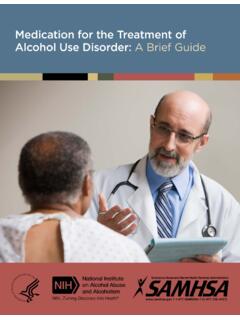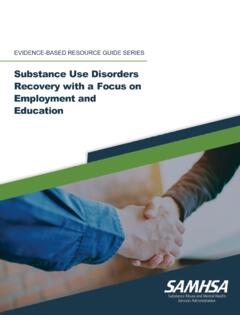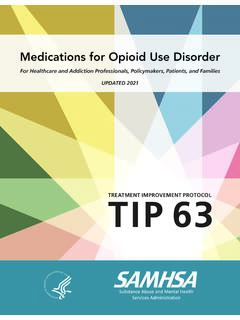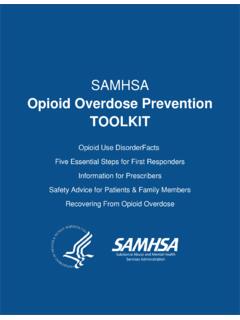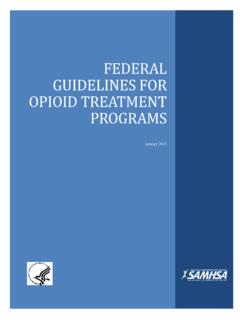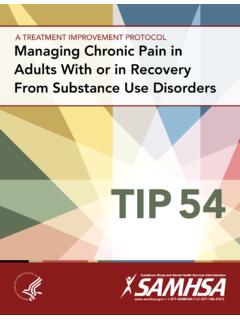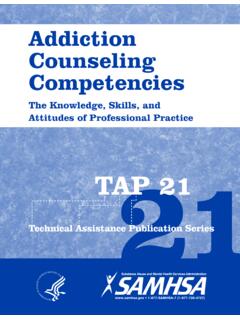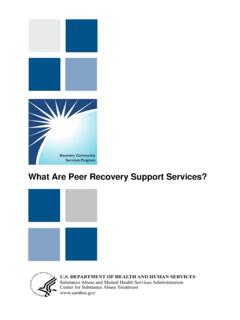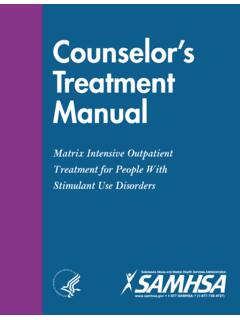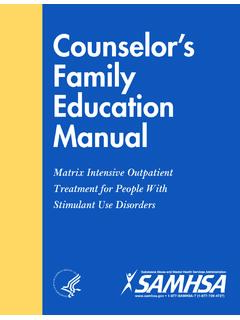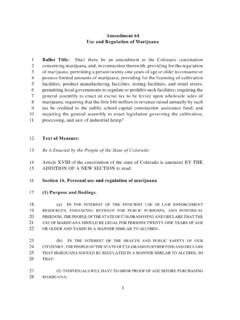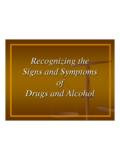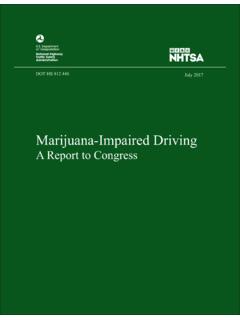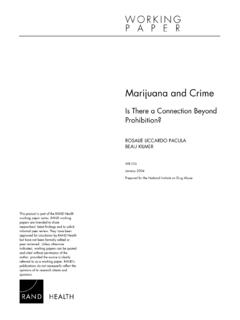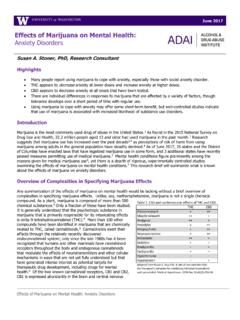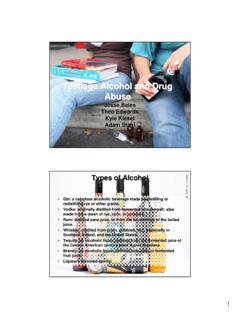Transcription of EVIDENCE-BASED RESOURCE GUIDE SERIES
1 EVIDENCE-BASED RESOURCE GUIDE SERIESP reventing marijuana Use Among YouthPreventing marijuana Use Among Youth AcknowledgmentsIPreventing marijuana Use Among YouthAcknowledgmentsThis report was prepared for the Substance Abuse and Mental Health Services Administration (SAMHSA) under contract number HHSS283201700001/ 75S20319F42002 with SAMHSA, Department of Health and Human Services (HHS). Donelle Johnson served as contracting officer views, opinions, and content of this publication are those of the authors and do not necessarily reflect the views, opinions, or policies of SAMHSA. Nothing in this document constitutes a direct or indirect endorsement by SAMHSA of any non-federal entity s products, services, or policies, and any reference to any non-federal entity s products, services, or policies should not be construed as Domain NoticeAll material appearing in this publication is in the public domain and may be reproduced or copied without permission from SAMHSA.
2 Citation of the source is appreciated. However, this publication may not be reproduced or distributed for a fee without the specific, written authorization of the Office of Communications, AccessThis publication may be downloaded from CitationSubstance Abuse and Mental Health Services Administration (SAMHSA). Preventing marijuana Use Among Youth. SAMHSA Publication No. PEP21-06-01-001. Rockville, MD: National Mental Health and Substance Use Policy Laboratory. Substance Abuse and Mental Health Services Administration, OfficeNational Mental Health and Substance Use Policy Laboratory, Substance Abuse and Mental Health Services Administration, 5600 Fishers Lane, Rockville, MD 20857, Publication No. NoticeSAMHSA complies with applicable federal civil rights laws and does not discriminate on the basis of race, color, national origin, age, disability, or cumple con las leyes federales de derechos civiles aplicables y no discrimina por motivos de raza, color, nacionalidad, edad, discapacidad o No.
3 PEP21-06-01-001 Released 2021 Preventing marijuana Use Among Youth AcknowledgmentsIIAbstractMarijuana use among youth and young adults is a major public health concern. Early youth marijuana use is associated with: Neuropsychological and neurodevelopmental decline Poor school performance Increased school drop-out rates Increased risk for psychotic disorders in adulthood Increased risk for later depression Suicidal ideation or behaviorAs policy and legalization efforts evolve and the availability of legal marijuana increases, communities and families need guidance to support the prevention of marijuana use among youth. This GUIDE covers programs and policies to prevent marijuana use among youth aged 12 to 17, including: Environmental strategies, such as regulating the price of marijuana products, where these products are sold, the products themselves, and their promotion and advertising School- and community-based substance use prevention programs to implement along with environmental interventions as part of a comprehensive prevention strategyThe GUIDE provides considerations and strategies for key stakeholders (including policy makers, community coalitions, businesses, school administrators, educators, and other community members), states, and the prevention workforce to prevent and reduce marijuana use among marijuana Use Among Youth EVIDENCE-BASED RESOURCE GUIDE SERIES OverviewIIIFOREWORDE vidence-Based RESOURCE GUIDE SERIES OverviewThe Substance Abuse and Mental Health Services Administration (SAMHSA)
4 , and specifically, its National Mental Health and Substance Use Policy Laboratory (Policy Lab), is pleased to fulfill the charge of the 21st Century Cures Act to disseminate information on EVIDENCE-BASED practices and service delivery models to prevent substance misuse and help people with substance use disorders (SUD), serious mental illnesses (SMI), and serious emotional disturbances (SED) get the treatment and support they of, treatment for, and recovery from SUD, SMI, and SED can vary based on several factors, including geography, socioeconomics, culture, gender, race, ethnicity, and age. This can complicate evaluating the effectiveness of services, treatments, and supports. Despite these variations, however, there is substantial evidence to inform the types of resources that can help prevent and reduce substance use, lessen symptoms of mental illness, and improve quality of life.
5 The EVIDENCE-BASED RESOURCE GUIDE SERIES is a comprehensive set of modules with resources to improve health outcomes for people at risk for, experiencing, or recovering from mental and/or substance use disorders. It is designed for practitioners, administrators, community leaders, and others considering an intervention for their organizations or communities. A priority topic for SAMHSA is preventing marijuana use among youth. This GUIDE reviews the related literature and science, examines emerging and best practices, identifies gaps in knowledge, and discusses challenges and strategies for panels of federal, state, and non-governmental participants provided input for each GUIDE in this SERIES . The panels included accomplished scientists, researchers, service providers, community administrators, federal and state policy makers, and people with lived experience.
6 Members provided input based on their knowledge of healthcare systems, implementation strategies, EVIDENCE-BASED practices, provision of services, and policies that foster change. Research shows that implementing new programs or policies requires a comprehensive, multi-pronged approach. This GUIDE is one piece of an overall approach to implement and sustain change. Readers are encouraged to review the SAMHSA website for additional tools and technical assistance marijuana Use Among Youth EVIDENCE-BASED RESOURCE GUIDE SERIES OverviewIVContent of the GuideThis GUIDE contains a foreword and five chapters. The chapters stand alone and do not need to be read in order. Each chapter is designed to be brief and accessible to anyone working to prevent and reduce youth marijuana use. The goal of this GUIDE is to review the literature on prevention of marijuana use among youth, distill the research evidence into recommendations for practice, and provide examples of the ways stakeholders can implement the RESOURCE GUIDE SERIES OverviewIntroduction to the BriefOverview of current approaches and challenges to reducing marijuana use among youth.
7 2 What Research Tells UsCurrent evidence on effectiveness of prevention strategies to address youth marijuana for Selecting and Implementing EVIDENCE-BASED Policies and ProgramsPractical information to consider when selecting and implementing programs and policies to address marijuana use among of Interventions for Prevention of marijuana Use Among YouthDescriptions of programs and policies that address marijuana use among for Evaluation and Quality ImprovementGuidance and resources for evaluating implementation of prevention strategies and programs, monitoring outcomes, and improving Substance Abuse and Mental Health Services Administration. (2020). Key substance use and mental health indicators in the United States: Results from the 2019 National Survey on Drug Use and Health. Retrieved from 2 D Souza, D. C., Radhakrishnan, R., Sherif, M.
8 , Cortes-Briones, J., Cahill, J., Gupta, S., .. Ranganathan, M. (2016). Cannabinoids and Psychosis. Current Pharmaceutical Design, 22, Jacobus J, Tapert SF. (2014). Effects of cannabis on the adolescent brain. Current Pharmaceutical Design, 20(13):2186-2193. OF THE GUIDEM arijuana use among youth and adolescents is a major public health concern. In 2019, about 1 in 8 adolescents aged 12 to 17 (13 percent) used marijuana in the past year, about million people. marijuana use during adolescence, a period when the brain is still developing, is associated with: negative impacts on brain development; poor school performance; increases in drop-out rates; increased risk for psychotic disorders and depression in adulthood; and suicidal ideation or policy and legalization efforts evolve and availability of legal marijuana increases, communities and families need guidance to support the prevention of marijuana use among youth.
9 For this GUIDE , the terms youth and adolescents are individuals aged 12 to 17. The purpose of this EVIDENCE-BASED RESOURCE GUIDE is to provide strategies for preventing youth marijuana use to states, communities, the prevention workforce, and other stakeholders. Youth are the focus, as significant evidence suggests early initiation is associated with some of the most serious harms. This GUIDE discusses programs and policies key stakeholders (including policy makers, community coalitions, businesses, school administrators, educators, and other community members) can implement to prevent and reduce marijuana use among youth and young marijuana Use Among Youth EVIDENCE-BASED RESOURCE GUIDE SERIES OverviewVThe framework below provides an overview of this GUIDE and prevention efforts that have been implemented and evaluated among youth. The review of these policies and programs in Chapter 2 includes specific outcomes, stakeholders, and delivery settings for the marijuana Use Among Youth Issue Brief1 CHAPTERI ssue BriefAddressing marijuana use among youth is a major public health concern.
10 Some studies suggest early use can cause disruptions to adolescent brain development that may result in negative consequences, such as cognitive impairment and delayed maturation of the brain areas responsible for Research on long-lasting effects has produced mixed results. However, there is increasing evidence that heavy and/or regular ( , daily or near daily) marijuana use among young people may be associated with cognitive deficits, such as impaired Other concerning risks include physical changes in the brain areas responsible for attention and memory, and increased risk for and early onset of psychiatric conditions and SUDs, such as schizophrenia and marijuana use Youth marijuana use is also correlated with suicidal ideation and behavior,10 poor school performance, increased high school dropout rates,12 and negative effects on male The full scope of long-term health and social effects of youth marijuana use is still unknown, particularly among those who may be using marijuana regularly or high prevalence of youth marijuana use is concerning.
